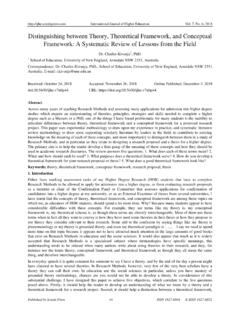Transcription of Models of youth work: a framework for positive sceptical ...
1 youth & Policy No. 109 September 201298 youth & POLICY, 2012 Models of youth work: a framework for positive sceptical reflectionTrudi CooperAbstractIn the post-welfare state, youth workers need Models to articulate the purpose and value of their work to politicians and the public, and to explain foundational assumptions about society, young people, values, and mechanisms for personal and social change. Robust on-going discussion about Models clarifies the relationship between theory and practice and enables youth work to make use of advances in knowledge in other disciplines, and to innovate constructively when faced with social and political change. Theorisation of Models of youth work flourished briefly in the final quarter of the twentieth century.
2 Renewed Models of youth work are urgently needed. To re-start this process, this article develops a framework for positive Scepticism Reflection. The framework is then used to review four Models of youth work developed between 1978 and 1994, to identify their contemporary relevance and where further theoretical work is required to meet the challenges of the twenty-first words: Models , youth work, theory, training, CONTINUed existence of youth work, and the sources of its funding, cannot be assumed in the twenty-first century post-welfare state. youth work will receive support only if policy makers can see a positive connection between youth and community work and their policy agendas, if commentators and the public can understand and value what youth workers do, and if youth workers have the tools to be able to refine and reinvent their own practice to retain core values in ways that are relevant to changing social circumstances.
3 Relevant Models of youth work can help youth workers to develop clear answers to all these questions, but presently, youth workers do not have such Models that will perform all these work in what I refer to as British-influenced youth work (BIYW) countries has diverged during the last thirty years. Triggered by incremental changes to government policy affecting both youth work goals and service delivery arrangements, Australian youth work is entering a period of re-consideration of the role of youth work, as evidenced by the extensive discussion about the nature of youth work at the 2011 Australian youth Affairs Coalition Conference. This process of deliberation offers potential for renewal, but can lead to vulnerability, especially if youth workers are not able to articulate the relevance of their work in a changed political landscape.
4 youth & Policy No. 109 September 201299 Models Of youth WOrk: A framework fOr positive sceptical refLeCTIONIn the Uk, the situation is somewhat different. Policy documents such as Benefits of youth Work (McKee, Oldfield, and Poultney, 2010) relate youth work to key values within government policy frameworks. Training standards documents (Lifelong Learning Uk, 2008) articulate the professional training standards required for youth work. However, as seen by recent cutbacks, youth work is also vulnerable in the Uk, even with such standards in place. There is still a need for greater theorisation and model development, both to refine youth work practice and to provide a basis for critique of youth work central purpose of this article is to revive interest in youth work theory development, especially in BIYW countries.
5 Renewed commitment to theory development is essential to the future health of youth work as an occupation, and to its survival as a distinctive form of practice. Theory development and shared commitment to purposes, values and boundaries provide occupations and professions with a number of benefits. An agreed theory base is essential to explain the contribution of practice to others outside the occupation. It also provides a necessary foundation to guide development of coherent and relevant education and training programmes for practitioners. A clear articulation of purpose and values enables well-considered and timely responses to social policy initiatives pertaining to youth work. A clear understanding of purpose and methods provides a basis from which to demarcate boundaries with other professions.
6 Finally, clarity about theory, purpose, values and methods is essential to the on-going quest to critically develop the discipline and the occupation, and to appropriately connect youth work to new knowledge as it emerges in cogent article builds both upon the method of personal reflection, questioning and scepticism discussed by davies (2006), and upon the work of Sterman (1991) who discusses the knowledge claims of Models , to develop a framework for positive sceptical Reflection. The framework is then used to critically assess selected historic Models of youth work to determine their theoretical adequacy, usefulness and contemporary relevance. The article concludes with a discussion about how youth work Models from the late twentieth century can be reworked to enhance their relevance to contemporary youth the two decades between the late 1970s and the late 1990s, several systematic attempts were made to develop schematic conceptual Models of youth work.
7 Commitment to theory discussion has continued within academia in the twenty-first century, (for example Batsleer and Davies, 2010; Bessant, 2004; Bowie, 2004; Corney, 2006; Jeffs and Smith, 2005; Martin, 2002; Sercombe, 2007; Smith, 2005). However, recent theory development has either focussed upon single issues or single approaches, or on issues concerned with professionalization, rather than the more encompassing youth & Policy No. 109 September 2012100 Models Of youth WOrk: A framework fOr positive sceptical refLeCTION projects of the late twentieth century. Simultaneously, conference discussions indicate that youth work practitioners have reverted to a- theoretical practice-oriented descriptions when faced with new policy environments.
8 Both theoretical and policy driven changes have contributed to this retreat from theory and caused the relevance of older Models to be questioned. Had a framework for positive sceptical Reflection been applied, these changes might have led to a flowering of dialogue, extension of theory, recognition of the competing and often contradictory discourses about young people, social relationship and social issues, and might have supported soundly-based practice driven changes that challenged the relevance of previous Models occurred as governments in both england and in Australia re-shaped political and institutional structures and practices that defined youth work. In Australia, this occurred during the 1990s, when competitive tendering replaced allocated funding for youth work provision.
9 This arrangement required youth organisations to compete with each other, and to demonstrate achievement of externally imposed targets and outcomes. As a consequence, and as a survival strategy, some youth organisations diversified their services beyond the traditional boundaries of youth work. In england, structural re-organisation of youth work occurred under New Labour when youth services in many boroughs and counties were incorporated into Children s and Young People s Services, Connexions, and Integrated youth Support Services. These policy directions served to blur boundaries between youth work and other professions and to undermine youth workers occupational identity by weakening the tie to employment conditions defined by the Joint Negotiating Committee for youth Leaders and Community Centre Wardens (JNC).
10 More recently, further weakening of youth services has occurred in Britain since the Conservative-Liberal democrat coalition took government. The coalition government has imposed substantial funding reductions and reorganisation of services, and has implemented its Big Society policy initiatives, which has continued use of externally imposed targets first introduced by New the academy, theoretical debates within sociology challenged the assumptions of some previous youth work Models . These debates emanated from the critiques of structuralist sociological perspectives, especially Marxian sociology, the rise of post-structuralist perspectives, and the on-going theoretical struggles within the discipline.








